The Wiki Strategy: How to Grow Your Blog to 100k+ Monthly Visitors
In August 2015, I was hired to lead marketing and content for Sumo. At the time, the blog was getting ~5,000 visitors a month, mostly from a couple posts being sent to the email list. Over the next 8 months, I grew it to over 170,000 monthly visitors, before my time there ended.
Since then, I’ve refined the core of the strategy I used there, and have been helping other companies implement similar systems. I worked with Patreon to take their monthly blog readers from 67k to 103k in 3 months, the Kettle and Fire blog from 22k to 50k in 3 months, and this site has grown to over 300,000 monthly readers in the last year.
But most blogs struggle to get over a few hundred visitors a day. And most companies that try blogging and content marketing as an acquisition strategy get nothing from it.
In almost every case, it’s because they’re focusing on the wrong things. Quantity over quality. Link building over question answering. Design over writing. Popups over value.
But a motivated content marketer in any niche can take a strategy like the ones I’ve come up with and apply it to their business and see massive success. Done properly, it can lead to tens or hundreds of thousands of new potential customers a month, arriving at your site naturally instead of by ads.
I’ve done it, I’ve trained people to do it, and with the right game plan, you can do it too.
There are certainly other strategies out there that work, but this is what’s worked best for me. It’s what I’ve seen the best results with, and what I recommend an enhanced version of to most companies I work with.
My goal is to give you a game plan you could use for growing your own product’s blog. Think of this as the expanded, improved, and larger-scope version of my Growing a Site from 0-10k article. That one is two years old now and was good for a smaller more personal blog. This article is for people who want to get serious about creating a content machine and making money from it.
I’ll start by outlining the core principles, then dive in more on how to properly do each of them.
Before I do, though, here’s how I’d recommend you use this.
- Read through it once to get a general idea of the strategy.
- Re-read the “Why You’ll Fail” section, and try to identify which errors you’re making.
- Go back through the guide and implement each piece one at a time.
This guide can be used to adjust an existing content strategy, or to build one from scratch. Once you understand the core principles, you can add in the pieces one at a time, and by the end of it, you’ll have a content machine that you can run with to dominate the information economy in your niche.
And if you want to learn about SEO in particular, be sure to check out my course SEO for Solopreneurs .
Core Principles of the Wiki Strategy
I call this the “wiki strategy” or “wiki strat” because we’re modeling off of the success of Wikipedia. No other site has played as successful of a content game as they have, so who better to emulate.
Principle 1: Create the Best Content Online
The first principle of the strategy is that you should only write something if it’s going to be the best article on that topic on the Internet. Anything less than that is a waste of time. If there is already a better article on the topic out there, then you’re only adding to the infomania pollution of the Internet by publishing yours, so you must only publish something if it is truly the best article on the topic.
Wikipedia is a great resource because of the quality of the content. You know there’s a certain standard the articles have to live up to, and the ones that don’t live up to it are clearly marked with warnings.
Your goal is to have the same brand recognition as Wikipedia, where no matter what article someone reads on your site, they know they’re reading something of extreme quality.
This takes a lot of time, yes. Some articles I’ve written took 40+ hours of work. But they’re worth it. That’s the difference between an article that can hold a top spot on Google for 2+ years, and an article that gets a little spurt of traffic then gets forgotten.
Principle 2: Create Rabbit Holes: Don’t Make Readers Leave
When you read a Wikipedia article, the body of the article only links to other Wikipedia articles. This helps ensure that there are consistent quality standards for everything referenced in the article, but more importantly, it keeps people in the site.
As you’re writing your own content, take note of when you have to link out to external sources to explain something. If it’s related to your niche, that’s an article that you should write for your own site, and do a better job with. Over time, you can keep going back and updating links in your articles that were to external sites to be to your own explanations, and keep people within your ecosystem.
This also helps you take more advantage of your most popular content by sending people to all of your other articles via that article.
Principle 3: Don’t Be a Slave to Keywords
Most people arrive on Wikipedia via search engines. They’re looking for information on something, and Google serves up Wikipedia. Google is a fantastic source of traffic, and SEO should be a core acquisition channel for you, but you shouldn’t sacrifice article topics and quality just to go after high value keywords.
Rather, you should have everything you want to write about, and then make sure that it’s as tailored for SEO as possible. This lets you take full advantage of search without creating the kind of bad content that comes from being too SEO driven.
Principle 4: Get Other People to Write With You
Jimmy Wales doesn’t write every article on Wikipedia. People who are interested in a topic contribute their time and energy to creating a good page about it. It’s impossible to churn out the best content online about every subject because you do not know enough to be an expert in everything about your niche.
Instead, you want other people to be a big part of your content strategy. You want to get the experts to contribute articles to you, or at least give you interviews, so that you can tell their stories and shape them into valuable articles. This is the only way to create consistent, high quality content, because you don’t know everything and your time is limited.
But this does not mean do expert roundups. Expert roundups are a lazy, terrible excuse for good content. Get a single person to write the definitive guide to the topic. Please do not pollute the Internet with more expert roundups.
Principle 5: Good Sourcing
This will apply more or less depending on your niche, but you need to be ruthless about what you cite within your articles. Another blog is very rarely a good citation, but it’s what most people resort to.
For health and anything science related, you should only be citing research articles. For marketing, only data or stories. For anything else, cite Wikipedia. Obviously, you should link to people when you’re telling their stories or mentioning their ideas, but you shouldn’t back up factual claims with other blogs. They aren’t reliable sources.
These are the five principles to keep in mind as you go forward. Write the best content online. Don’t make readers leave. Be keyword informed but not driven. Get other people involved. And make sure you’re doing good sourcing.
Once you have those fixed in your brain, we can get into more of the mechanics. Each piece of the strategy builds on the last, so by the end of it, you’ll have a well-designed content machine that you can run with and dominate the web.
Here’s how we’re going to build it up:
- Setting and tracking content goals
- Choosing and planning your content
- Being SEO informed
- Getting other people to write the best content online
- Organizing the content machine and editorial process
- Promoting your content
- Why you might fail
Setting and Tracking Your Content Marketing Goals
You won’t get anywhere if you don’t know what you’re aiming at. Since a blog like the one we’re discussing is primarily focused on selling a product or service (as opposed to more niche-less blogs), you should start with a sales goal sourced from blog content.
For example: Grow to 300 widgets per month sold to customers acquired via blog traffic within 6 months.
From there, work backwards to a conversion and a traffic goal. By using “paired” metrics, you’ll make sure you don’t get bad traffic, and that you don’t just have a great conversion rate on no visitors.
Now you have three goals:
Sales Goal : 300 units sold via the blog per month in 6 months.
Conversion Goal: 1% of visitors convert to purchasing.
Traffic Goal: 300 / 0.01 = 30,000 visitors per month in 6 months.
Then, you can take where you currently are, and plot it out in a spreadsheet for the next six months to give yourself a ramp up to where you need to be. If you’re getting 5,000 visitors a month right now, you might create a ramp up like this:
(You can make a copy of this spreadsheet for free here).
Then each month, you adjust your goals for the upcoming months based on how you’re doing. If you’re way under you might try to see what other levers you can pull to raise it up, or if you’re over, you can set an even higher goal.
Also, since you’re working with two metrics, you could adjust one based on the others’ performance. So if you’re able to get a 4% conversion rate consistently, you might not need to increase your traffic at all. It’s up to you to decide which levers to pull.
Tracking
I personally don’t like creating extremely complicated tracking systems. It distracts from the most important part of the plan, which is creating good content. It shouldn’t take more than 30 minutes a week to get a quick sense of how you’re doing and to report it. To some, this might seem insufficient and that you should be tracking more, but that quickly becomes a waste of time and form of fauxductivity.
If you want to add to this spreadsheet, I’d start by breaking it out by week instead of by month. Then you could add more precise tracking per-article for how it’s ranking and performing in search, as well as tracking your different CTAs to get closer to your goal. Just make sure that whatever you add for tracking has a specific reason it’s there. Don’t fall into the trap of tracking just for the sake of tracking.
Choosing and Planning Content
A blog for a company or product is ultimately there to help sell whatever it is they’re selling. With Sumo, we were trying to get people to install email popups. With Zapier, it was about getting people to set up their own automations. With Patreon, getting people to create Patreon pages.
Whatever your blog is trying to sell, the goal of the information in it has to be to help educate potential customers about anything tangential to the benefit your product or service provides. That’s why Sumo was all about internet marketing, Zapier talks about apps and productivity, and Patreon talks about making it as an artist.
Let’s use Sumo as an example. In planning out the content, I tried not to think of it as a “blog,” but rather as a database. I wanted reading through the blog to be a masterclass in growing a site, so that new Sumo users would be able to grow their own sites and eventually have a reason to buy the pro plan of the product.
That meant that we needed to have the best information online about how to get more traffic to your site.
After a few initial blog posts, I started thinking more about how I could systematize the knowledge collection. How would people navigate through our content? Where would they start? That eventually led to what was (I don’t know if it still is) our most popular article ever: 130 Ways to Get More Website Traffic: A Sumo-Sized Guide.
My goal with the article was to make a list of every single possible way someone could get more traffic, and then to see who had the best content out there on how to do those things. For each tactic, there was a “getting started” snippet which usually linked to someone else’s article:

That was only temporary, though. My goal was to eventually replace all of those links with links to our own articles. Just as Wikipedia articles only contain links to other Wikipedia articles, I wanted to create content to fill in all those gaps so that someone would never have to leave our site to learn everything they ever needed to know about Internet marketing.
Once that cornerstone article was done, I created a spreadsheet with every single tactic that we listed. This became the base of our content plan, since I knew that every single related topic was a good opportunity for content on our site.
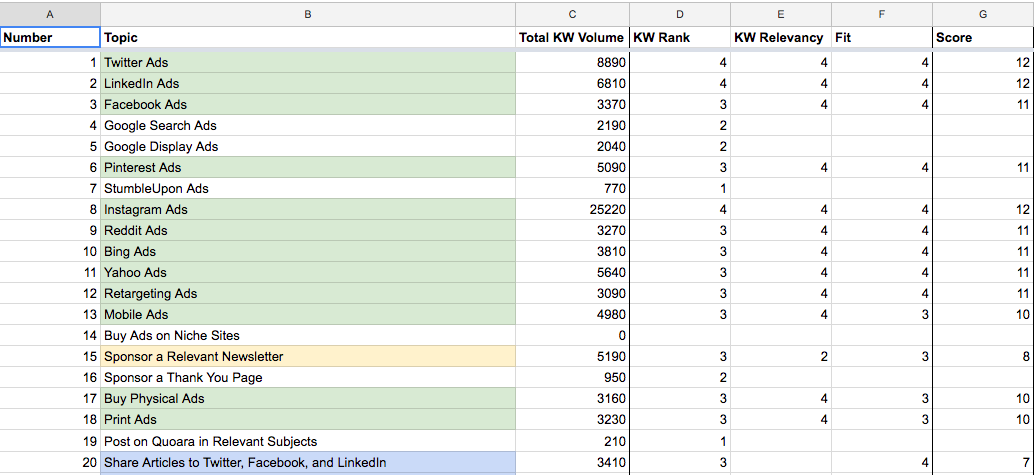
You could do something similar in almost any niche. Write one, massive, cornerstone article on the benefit you want to provide your audience, and then use that article to inspire the other articles you need. As you keep creating articles, you’ll think of more and more content that you need in order to fill in all the gaps, and that can keep going into your content spreadsheet.
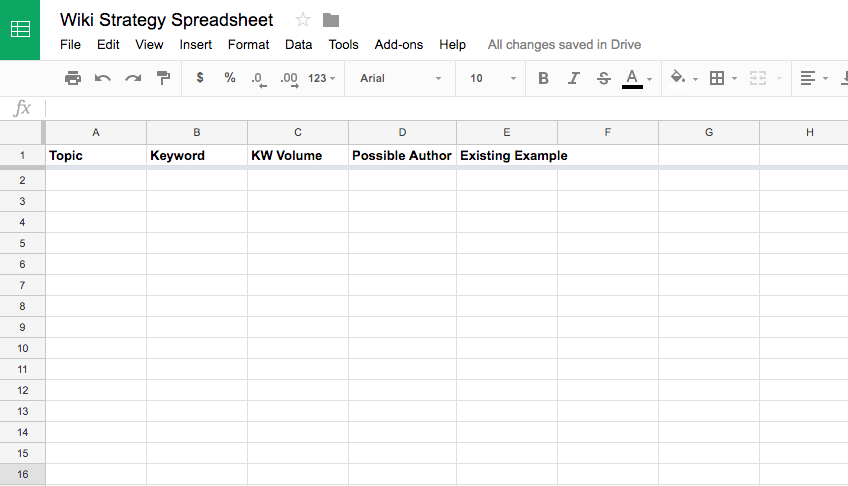
As the list grows, you have to figure out how to prioritize them and who should be writing them. This is where we bring in the idea of being “SEO informed, but not driven.”
SEO Informed, not Driven
With your list of topics, the next question is which ones should you write about first and how should you organize them. I prefer to prioritize based on the SEO opportunity since people you get to your site via search will be more interested in buying something (compared to social), and if you do it right, SEO can be a source of free, recurring traffic for years.
For each topic, I plug it into a keyword research tool like ahrefs to get a sense of how valuable of a topic it is, and how valuable the related topics are.
To do that, you take the exact topic, say “how to brew black tea,” and plug that into the search bar, then click “also ranked for” to see the search terms that are most popular related to that topic:
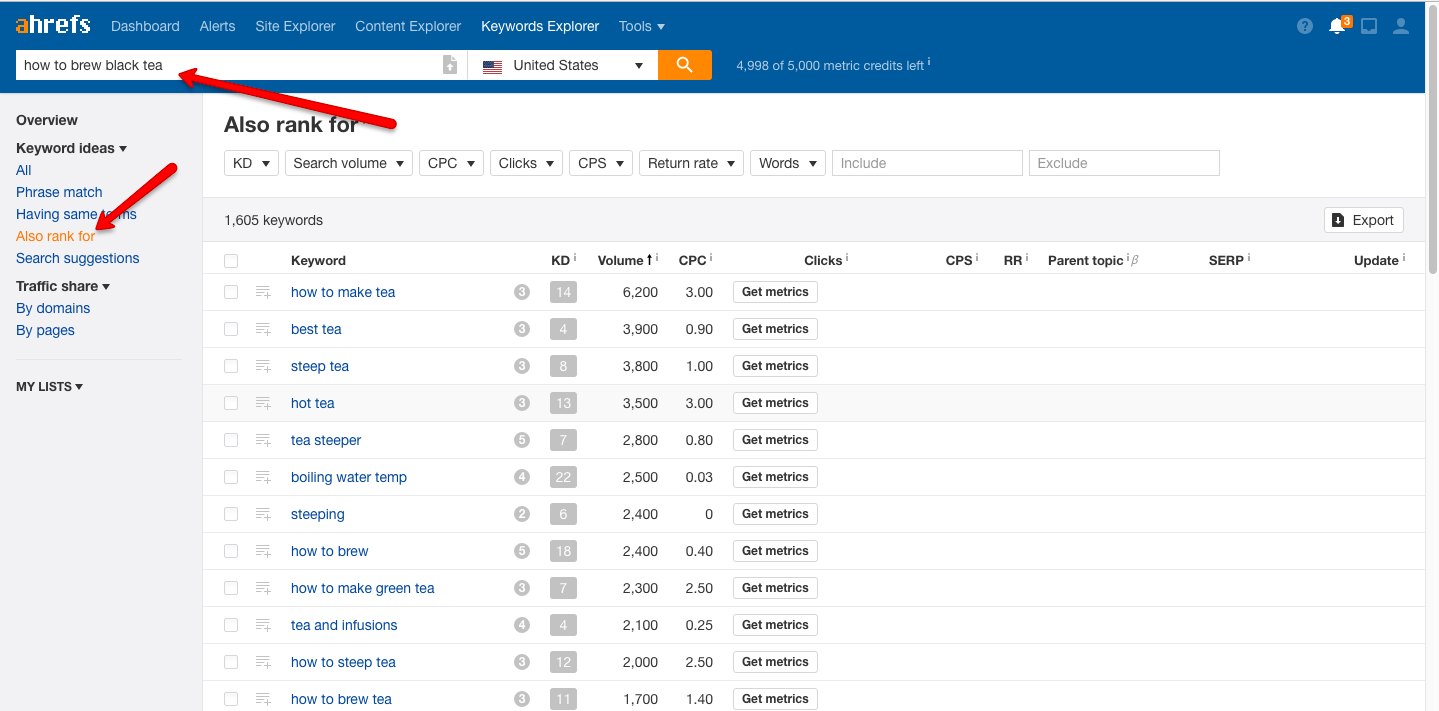
Then, you can go to Google, type in your topic (how to brew black tea), take the article that’s ranked #1, plug that into Site Explorer, and then see what are the best keywords it’s ranking for.
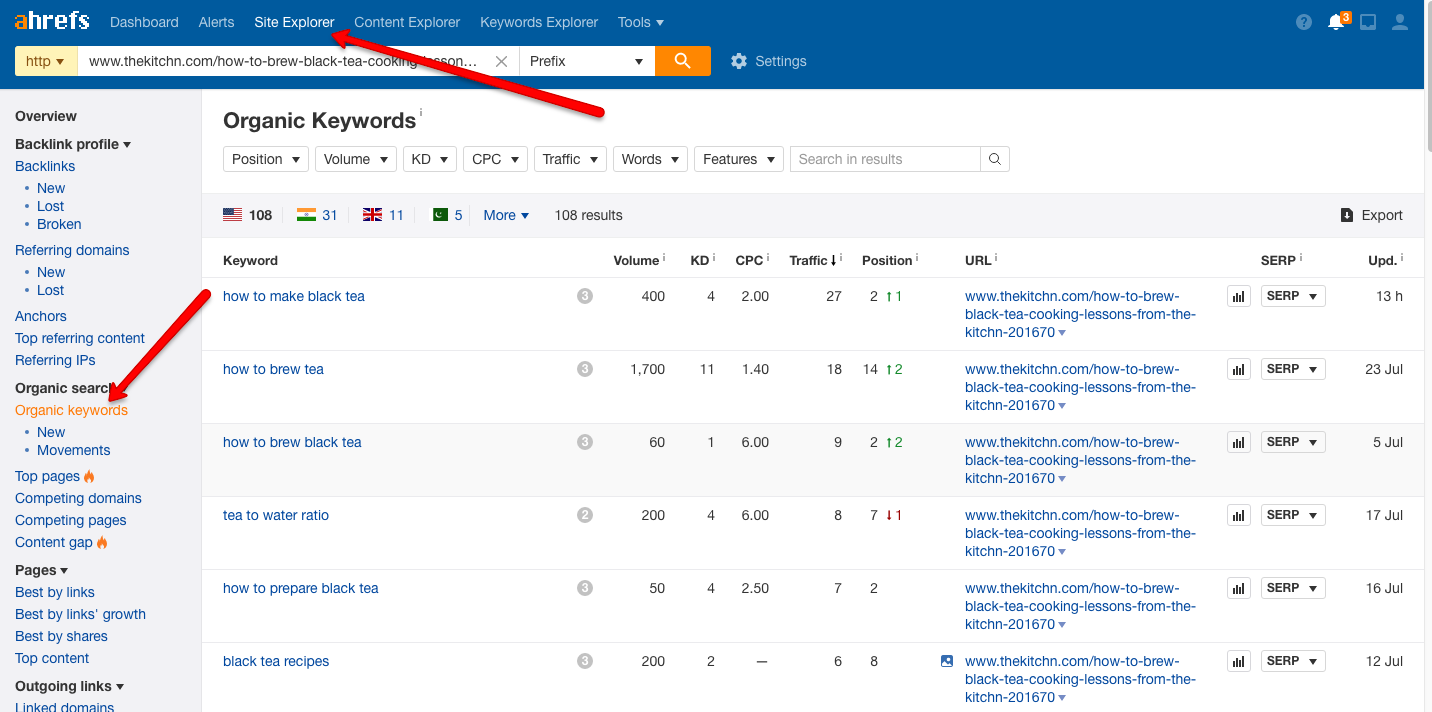
By looking at the results of these two methods, you can figure out which keyword to base your article around, based on the difficulty and the search volume. Add this to your spreadsheet, and keep doing it for every new topic you add in.

When you’re done, you’ll have a birds-eye view of the highest opportunity keywords (the ones with high volume and low difficulty). As your traffic increases, it will be easier to rank for higher difficulty keywords, but in the beginning, focus on the easier ones. At this point, you’re ready to start writing.
Or, better yet, get someone else to start writing.
Getting Great Guest Contributors
For each topic that looks like it has good potential, identify who seems to know the most about it online, hunt down their email address, and reach out to them about guest posting on the topic.
This ensures that you’re getting experts for each topic, instead of random “me too” bloggers who are repackaging other people’s content. Don’t get in the habit of repackaging content! The more you can get original, expert takes on how to do something the better your content will be.
But getting good guest posts is hard, so you have to make it enticing. What I told potential guest posters for Sumo was:
- We will promote you to our whole email list
- You can link to yourself as long as it doesn’t look spammy and it’s good content
- This will be the best article on the Internet on this subject so we will promote it forever and ever and ever
That led to some insanely good articles, like these ones on doing a Kickstarter launch, going on podcasts, validating business ideas, growth hacking reddit, and effective guest posting.
You’ll notice right away that these are not normal guest posts. The authors clearly put a ton of time and effort into them, and they did that because I promised them a return on their efforts.
I was also a huge pain in the ass as an editor. Having worked with other sites on their content, I can safely say that no other marketing blog sent back as many edits, suggestions, and requests for more info as I did. I’d usually give articles a one month lead time because I knew there would be a significant amount of back and forth on improving them.
But it was always worth it. The articles came out excellent, and the guest posters always said they were really proud and excited about what they’d written. Better yet, since they’d done such a good job with their article, they would regularly link to it from their own sites which boosted our SEO.
Organizing the Content Machine
So far we’ve mostly covered tactics for writing articles, but we haven’t covered how to get this whole thing operating on a good schedule.
For Sumo, I ramped up the content creation like this:
- One article a week by me
- One per week by me plus one guest post
- Two guest posts per week
- Two guest posts per week plus one article by Sarah
Three articles per week seemed like a good stopping point. Any more than that and it would have gotten hectic, and three great articles per week is more than enough to quickly grow your site.
To manage all of it, I used a combination of Google Calendar, Google Docs, Trello, and a Google Sheet like the one in this article. Each
Monday, I would pick three articles that I wanted to add to the queue, Sarah would pick the one she wanted, and we’d find writers for the other two. Once I found someone to write them, they would go on the next available calendar spots for Tuesday, Wednesday, or Thursday in about a month. The calendar was good for giving us a high-level view of what was coming out, and to make sure there was a good diversity of content.

Then the article would go into a Trello board like this one in the Assigned column. I’d set it due for when I told them I needed the draft by, and tag myself so I got notified to follow up with them:
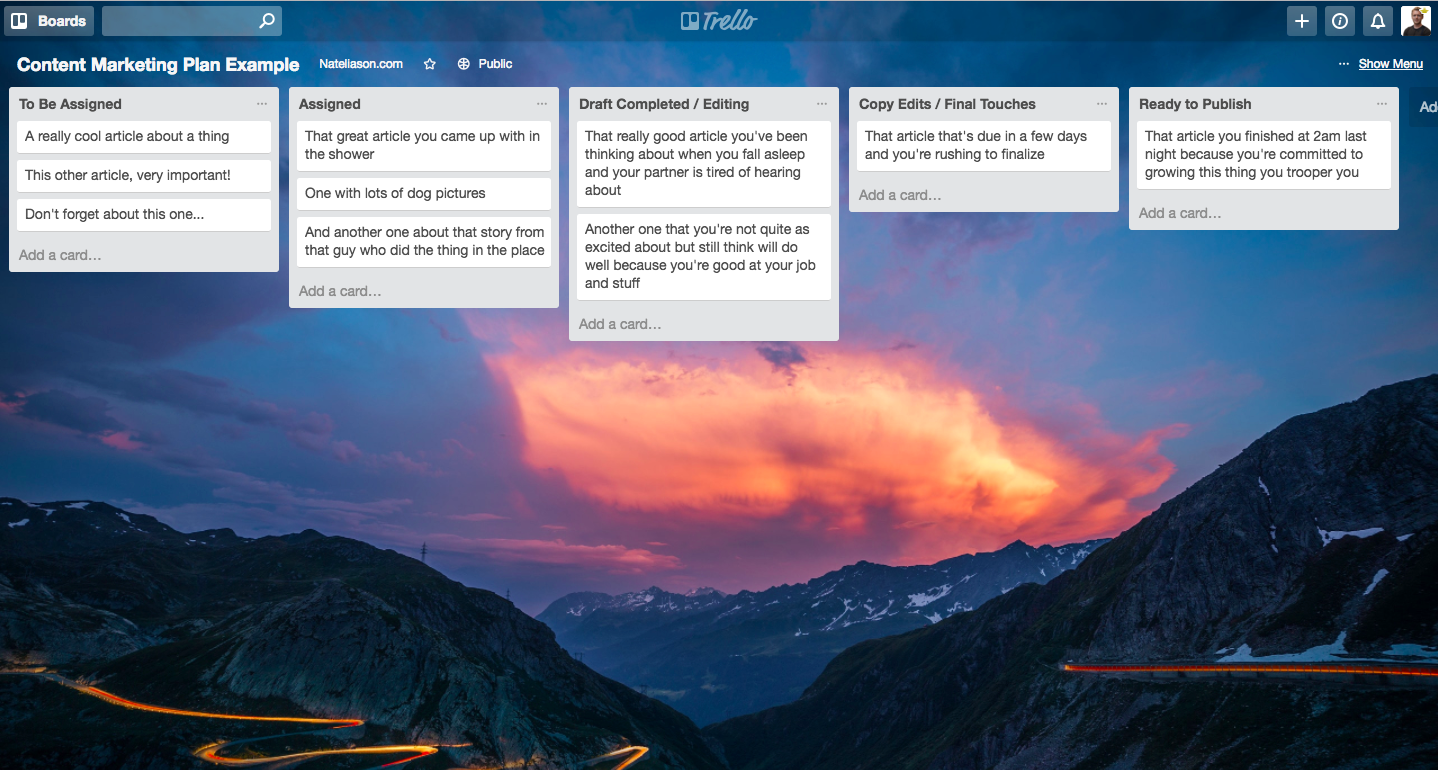
(Link to board: https://trello.com/b/fMaMbs9E)
Once I had a draft, I’d send back edits and give them a week to make the changes. Then it’d go in the Draft Completed / Editing column. Once all of the edits were done, it’d go in the final touches column where we could add a header image, content upgrade, things like that, to get it “ready to publish” on Monday of the week it was supposed to go live.
This helped immensely as I added people to the system. When you have a well-managed editorial board that you can add other freelancers and employees to, everyone will have a much better sense of what’s going on.
Just don’t let it get too crowded. If you let cards age and start adding tons of ideas and random stuff to it, the whole system gets weaker, so be religious about keeping your editorial calendar board active and with as few cards in it as possible. If you want to use Trello for capturing ideas, put them in a separate board.
I also kept links to all of the Google Docs in the Trello cards, and in a shared Drive folder everyone on the team had access to. This prevented any permissions issues, and by writing everything in Google docs it’s easy to quickly upload your posts to WordPress using Wordable.
The most important part of all of this is that deadlines are not negotiable. A number of sites I’ve worked with are loosey-goosey on deadlines, and it creates a mess for publishing content regularly. Once you have the system in place, you need to be extremely strict with yourself about publish dates and make sure you hit every single one. Even if you have to stay up all night the night before, let that be a lesson to plan more in advance in the future. Deadlines are not suggestions.
You’ve should have a solid content machine running now, so the last piece of the puzzle is how do you promote these articles you’re publishing.
Promoting Your Content
Promotion could be its own massive article, and it will vary significantly among different people, but I can give you some high-level guidelines.
The first is to ignore the common advice that you should spend “80% of your time on promotion, 20% on creation.” That’s a horrible idea and will guarantee that you’re promoting bad content. Instead, spend 80% of your time on creating the best articles online (principle #1), and the last 20% on getting them in people’s hands. Good stuff tends to spread on its own, bad articles, you have to force.
Since you’re going to be SEO driven, articles you publish should start to rank over time. Give an article 2-3 months before you pass judgment on how it’s ranking. I’m generally against link building, keyword stuffing, and a lot of “active” SEO techniques. Instead, I recommend simply writing the best article you possibly can, fitting the headline to the topic and then waiting.
In addition to SEO, you have a few options. Aggressive email list building works, but it ruins the experience of your site. You can also use social media, but you’ll have less control of your audience compared to email. Fewer than 10% of your followers will see a Facebook post, fewer than 5% will see a tweet.
There’s also influencer marketing, guest posting, reddit, forums, the list goes on. Whatever you decide to start with, I strongly recommend following the Bullseye Framework from Traction where you pick a few experiments you want to try, run them, and then if you get good results, you implement it as a system and then move on to the next experiment.
If I had to give an order of priorities for what promotion systems to set up for a blog though, it’d look something like this:
- Non-annoying email collection + newsletter for new articles
- Automated social sharing with Zapier + evergreen sharing with Postplanner
- Hiring someone to plug articles on reddit
- Reaching out to everyone mentioned in articles
- Reposting articles to Medium publications + LinkedIn
- Republishing / syndicating articles on other sites
- Boosting content on Facebook
- Adding an additional medium (most likely YouTube videos or a podcast)
You’d start with #1, and not start adding in #2 until you had #1 locked into a good system that would be easy to hand off to someone else.
At this point, you should have a strong, thriving content machine. One where you know what you’re writing, getting other people involved, keeping it all moving smoothly, and promoting what you’re creating.
Now let’s look at why it might not work.
Why You Might Fail
This strategy will work for anyone, assuming you don’t get stopped by the common reasons that people fail to grow popular blogs.
Reason #1: Your Content Isn’t Good Enough
The most likely reason you’ll fail is that your content isn’t good enough. Whenever I talk to someone whose blog isn’t working, the uncomfortable truth I usually end up having to tell them is that their content simply isn’t good. It doesn’t deserve to rank for SEO, doesn’t deserve to be returned to or shared, and doesn’t deserve to get subscribers.
You have to seriously ask yourself if your content is as good as the best in your field, and if it isn’t, how can you get it there? Find the best blogs in whatever market you’re trying to dominate, assess what they’re doing well, and then see where you can emulate them or do better.
Reason #2: Inconsistency
If you publish randomly and rarely, you’re not going to grow. Pick a schedule and stick to it. Obey the Trello board or whatever other system you come up with like your life depends on it. If that means pulling an all-nighter to finish an article, so be it. Yes, it’ll suck, but it’ll teach you a valuable lesson about procrastinating your content in the future.
Reason #3: Wasting Time on Distractions
Many budding bloggers try to do everything at once. They do all of the social media profiles, the blog, they try to get guest posting opportunities… chill out. You’ll burn yourself out and spread yourself too thin and never get anywhere.
Pick ONE acquisition focus, ONE retention channel, and ONE engagement channel. Forget the rest. You can have them run on autopilot just so they’re there, but don’t worry about them.
My stack is SEO, Email, and Twitter, but yours might be different. Maybe you want to do Social, Facebook Group, and Facebook. Or Referrals, Slack, and Meetups. Pick your stack and stick to it. If you want to branch out later, you can, but only after you’re sure that it won’t distract you.
If you can avoid those three traps, you should be good. The only last thing you need to do is be patient. The Sumo blog grew very quickly, but we had years of AppSumo reputation to go off of. This blog took 6 months before it had its first day over 1,000. Yours likely won’t blow up overnight, but when it does start to take off, you’ll have a backlog of good content to keep people engaged.
Chill out, stick to the plan, and you’ll get there. I believe in you. And if you need help doing this for your site or startup, hit me up on Twitter or reach out about working together.
And if you want to learn about SEO in particular, be sure to check out my course SEO for Solopreneurs .